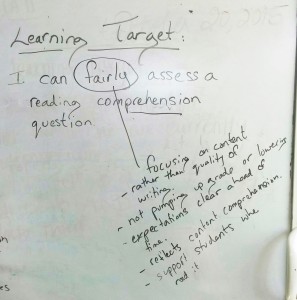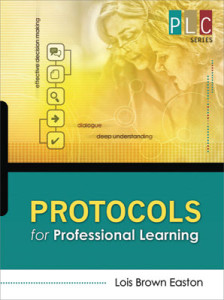Using Protocols in Professional Development
In one of my favorite Twitter chat groups, #BFC530, someone recently recommended the book Protocols for Professional Learning by Lois Brown Easton. Intrigued by the idea of using protocols in professional development, I immediately ordered it.
I’m so glad I did: it’s a simple, easy-to-read guide that first explains how protocols work, then presents a variety of protocols to use in different situations. The protocols are easy to follow, so the Language Arts teachers and I decided to jump right in and give one a try.
We decided to apply the protocol to a recent problem we’d encountered. A new Language Arts teacher was struggling with grading her students’ answers to reading comprehension questions. For those questions, students had to give a reaction or an opinion, include supporting evidence for their reaction, and then analyze how their supporting evidence backed up their opinion. The teacher was finding that, in grading these responses, her grades seemed generally higher than what the students’ work actually merited. Being a risk taker who responds well to feedback, she volunteered to be the guinea pig for our first attempt at using the protocol.
 We began the meeting by unpacking our learning target: “I can fairly assess a reading comprehension question.” Right away, we noticed problems with the word “fairly.” If a student is struggling with English, do we grade “on a curve”? If so, how do we show growth over time? The unpacking of the learning target engendered quite an animated discussion of issues that we needed to discuss and misconceptions that we needed to clarify. Once we agreed on our definition of “fair” grading, we moved on to the protocol.
We began the meeting by unpacking our learning target: “I can fairly assess a reading comprehension question.” Right away, we noticed problems with the word “fairly.” If a student is struggling with English, do we grade “on a curve”? If so, how do we show growth over time? The unpacking of the learning target engendered quite an animated discussion of issues that we needed to discuss and misconceptions that we needed to clarify. Once we agreed on our definition of “fair” grading, we moved on to the protocol.
The protocol works on a fairly strict agenda – giving specific time for presentation, questioning, discussion, and wrap up. I was a bit nervous about following this time structure…was it realistic? Would 15 minutes be enough time for a discussion? It seemed a little too short to be realistic, but in the spirit of experimentation, we decided to follow the time constraints to the letter.
The protocol allowed time for the presenter to describe her teaching situation while the rest of the group took notes. She passed out samples of her students’ work for everyone to look at. Then teachers had time to ask clarifying questions and about five minutes to silently take notes and reflect on what they’d seen. After the reflection, the participants discussed their ideas while the presenter remained silent and took notes. Finally, the presenter reflected on what she learned.
At the end, we debriefed on the protocol, and teachers were amazed at how much we managed to get done in less than an hour. Everyone was highly engaged in rich discussion and, from our novice teachers to our most experienced teachers, we all learned from it.
What makes the protocol effective:
- It allows the teachers to actively lead their own discussion.
- The time limits forced us to remain focused on our tasks.
- The presenter can’t speak during the discussion, which allows for a free flow of ideas and keeps the presenter from becoming defensive.
Since the protocol was so successful, we’ve tried it in other professional development meetings. Teachers have presented projects and asked for help in refining them, and our psychology department used a protocol to help us decide on how to regulate students’ use of cell phones at school. In every debriefing, teachers were impressed with the depth of discussion and the level of engagement.
Once teachers saw how effective the use of protocols was for professional development, they naturally took the next step and began to use it with students in the classroom… with great results!



Leave a comment